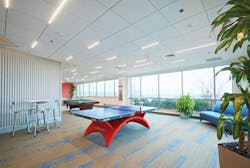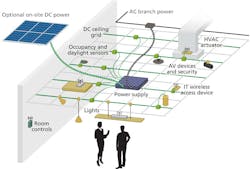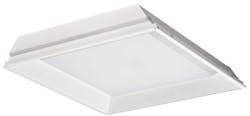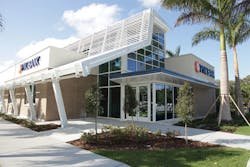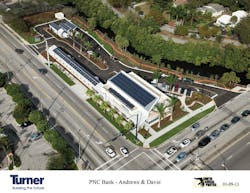Minimizing power conversions can save energy in any electrical system, and LED lighting is a good match for a DC grid and also renewable energy such as solar power in green buildings.
By Maury Wright, Editor, LEDs Magazine and Illumination in Focus
Driven by energy cost, the lighting industry sector has been on an energy-efficiency mission, going back more than half a century to the broad deployment of fluorescent lighting in commercial settings, and gaining in earnest in the 1980s with the development of the compact fluorescent lamp (CFL). Increasingly, however, it’s become clear that minimizing energy usage goes far beyond the light source. Indeed, we have regularly covered controls that can compound savings through occupancy sensing and dimming. The opportunity for better efficiency also extends to the power grid both inside and outside of buildings and to renewable sources such as solar. Let’s discuss how DC-grid technology can deliver significant energy savings, especially when combined with inherently efficient LED sources.
The broad topic of DC versus AC grids is beyond our scope here, but if we look inside a commercial building the opportunities for DC distribution become clear (Fig. 1). There are two primary reasons that now may be the time for DC power distribution in buildings. First, we can minimize the number of lossy power conversions with a DC grid. Second, renewable sources such as solar panels produce DC power. And despite the relatively low conversion efficiency of solar panels, they can power efficient LED fixtures.
Energy losses
Power conversions inherently result in power lost as heat. Conversions happen in AC/DC power supplies that also may convert voltage level, and in DC/DC power supplies that only convert voltage level. Note that the so-called driver used in LED lighting is simply a constant-current power supply. Generally more conversions equate to greater energy lost, and larger level changes are less efficient than smaller level changes.
Today, the bulk of our devices that require power in homes and businesses need DC power. Nicole Bopp, director of marketing at Nextek Power Systems, said that ultimately 80% of the watts used in the home power DC loads. Indeed, mobile phones to PCs to flat-panel TVs could be powered directly by DC. In commercial buildings, you can add the power-hogging IT data centers to the list. All of these DC devices require power-wasting converters to operate.
Legacy lighting, however, has been able to operate directly from the AC line. But that lighting has been itself inefficient and the reason that lighting consumes somewhere around 30% of the total energy used in the United States. LEDs promise to slash the energy use attributable to lighting in general and DC power distribution can enhance overall efficiency.
EMerge Alliance
There is an organization promoting DC power distribution in the US called the EMerge Alliance (www.emergealliance.org) that is supported by large companies ranging from lighting manufacturers to major players in the IT sector. The organization has been primarily focused on DC distribution for data centers and lighting in commercial buildings. Brian Patterson of Armstrong World Industries and chair of the EMerge Alliance said that those applications would deliver the most in energy savings with a transition to DC distribution. More recently, the EMerge Alliance also announced that it will push adoption of DC distribution for homes and small businesses to support applications such as rooftop solar, LED lighting, and electric vehicle charging.
The EMerge Alliance has gained significant momentum in the lighting industry and has had a major presence at Lightfair International (LFI) for several years. This past spring at LFI, the organization announced that it had reached 100 member companies. There are compliant products available from industry leaders such as Acuity Brands, Osram Sylvania, Philips, and many more. You can find a complete list of registered products on the alliance website.
In a typical scenario based on EMerge standards, a single power supply might power as many as 100 LED-based fixtures via a 24V DC bus (Fig. 2). The power supply can accept an AC input in a typical commercial space that is already wired for AC, or a DC input when there is an enterprise DC grid or power from a solar system. Nextek has a product with dual inputs that can operate from solar when that power is available and seamlessly swap to AC when the sun goes down.
In this article we won’t dig deeper into the details of how a DC grid operates, but you can find more of that information in a feature article that ran last summer in LEDs Magazine. Here we will concentrate on the advantages of DC, the potential of solar power, and some actual product and deployment examples.
DC advantages
The advantages of a DC grid certainly start with the aforementioned efficiency gained through fewer power conversions, although there are also significant logistic advantages. The Class-2 low-voltage wiring that connects fixtures is far simpler in installations relative to AC systems where conduit must be run to each fixture. Indeed, in a DC scenario, a building owner could modify room lighting without the need for an electrician.
The 24V bus can even be run directly in a drop-ceiling grid frame. For example, Armstrong offers the DC FlexZone system in both the Suprafine T-bar and Silhouette product lines. The main beams carry the DC bus power and are used with standard cross tees and other drop-ceiling accessories. A simple connector and short cable attach to the main beam then connect to the lighting fixture. In such an installation, fixtures can be easily moved and rearranged to match changes in an office space.
Luminaires can be mounted directly on the FlexZone frame. For example, spotlights can be mounted to the grid almost as if it were a track fixture (Fig. 4). JLC-Tech offers a series of different T-bar LED products that are linear in nature and essentially become part of the grid. Fig. 1 depicts such an installation at the offices of AWeber Communications in Chalfont, Pennsylvania.
The system also supports standard recessed troffer fixtures including both LED-based products and fluorescent fixtures. Fig. 3 depicts an Acuity troffer that is compatible with EMerge standards and FlexZone ceilings. The efficiency advantages of a DC grid also apply to fluorescent installations, but fewer fluorescent fixtures can be powered by an EMerge power channel because generally fluorescent fixtures require more power than do LED fixtures.
Renewable energy
Proponents argue that DC grid technology offers sufficient advantages that a transition to DC is warranted at some level purely based on the previously discussed elimination of lossy power conversions and the logistics advantages. Ultimately, however, the good match between renewable sources and a DC grid might be the piece of the puzzle that leads to broad deployment. When it comes to lighting, LED technology is a key piece of that puzzle as well.
While it’s commonplace across the US and in many places around the globe to see solar panels on roofs and wind turbines in both urban and rural areas, renewable sources are far from a perfect solution to energy issues. Energy sources such as wind and solar are diffuse, and therefore we need large areas to capture sufficient energy. Capturing and storing such energy remains more expensive than using fossil fuels. There is a very good article on the challenges on The Energy Collective website.
Still, as prices for products such as solar panels drop, it becomes increasingly more realistic to use roof-top solar locally to power a home or commercial building. In the case of solar, the challenge remains efficiency. Panels today are still limited to efficiency ratings below 15%.
But it’s the mating of a renewable source with energy-efficient technologies that can pay off at the building level. Terry Walsh, president and CEO of lighting manufacturer Tempo Industries, refers to “LED lighting technology as symbiotic and enabling when used with other ‘clean tech’ technologies.”
At The LED Show in August 2013, Walsh said, “LEDs breathe life into solar.” His point was that LED lighting is efficient enough to be powered by localized solar energy, especially when combined with controls. In such cases with controls, Walsh more recently said a solid-state lighting (SSL) installation can deliver 80–90% energy savings compared to legacy lighting systems. He added, “It is reasonable and achievable to potentially see a parking garage, for instance, drop its power requirements enough to go off grid.” The DC grid adds to the renewable potential.
LEED platinum example
Given the advantages we’ve discussed, it’s a fair question to ask why there aren’t readily-available examples of real-life installations, and why broad deployment hasn’t begun. In the case of EMerge-compliant products, 2013 marked the first time there were truly sufficient numbers of lighting, power supply, and accessory products to support a commercial-scale project with diverse lighting needs.
Still, at least one major project came on line in 2013 that uses a DC grid and solar technology along with a host of other green practices. In early 2013, PNC Bank opened a new branch office in Fort Lauderdale, Florida that the company said exceeds LEED (Leadership in Energy and Environmental Design) Platinum requirements (Fig. 5). The branch was designed as a net-zero building, meaning that it generates more electricity than it uses.
The PNC branch uses many of the technologies we’ve discussed in this article and in other recent Illumination in Focus features. The company has said that the solar panels visible in Fig. 6 feed a DC ceiling grid to power the indoor lighting. The bank has not mentioned the EMerge Alliance but Paul Savage, CEO of Nextek, said the branch uses the DC FlexZone powered by Nextek EMerge-compliant Power Serve Modules (PSMs) and that other fixtures connect directly over low-voltage wiring to the PSMs.
Daylight harvesting also plays a key role in the energy efficiency achieved by PNC. As we covered in a feature last April, daylighting can reduce the reliance on artificial lighting during daytime hours. In the PNC case, sensors dim or extinguish lights when daylight is plentiful.
Other building systems
The bank building design also plays a part in the daylighting and in minimizing energy used by the HVAC system. A solar shade that’s evident in Fig. 5 reflects some sunlight during the hottest time of the day to reduce the energy used for cooling. Still, the shade allows sufficient daylight to pass, minimizing the need for artificial lighting.
PNC also used adaptive controls for occupancy. Sensors that detect vacant spaces can trigger both lights and computer monitors to shut off. The bank branch has many other green features including a ventilation system that recovers energy and a vertical plant wall that helps cool the building.
PNC has yet to reveal any details about how much the individual elements such as the DC grid add to energy efficiency. But the bank has revealed projections for the 4900-ft2 building. PNC expects the design to produce 84,000 kWh each year while consuming 70,000 kWh. The difference is enough to power a 1600-ft2 home according to PNC. PNC said the branch uses 50% less energy than a typical bank branch of comparable size.
DC proponents can make the case that we would be better off with a DC grid as the basis of our entire electrical system. But that horse has proverbially left the barn. Still, new buildings will be able to adopt DC as the primary grid going forward. The key to broad acceptance, however, is the ability for buildings to use a hybrid approach, and that has guided the efforts of the EMerge Alliance since inception. The standards have been crafted such that DC technology can be adopted at the room to building level, and that makes it perfectly suitable for retrofit scenarios. We expect to see much broader DC usage in 2014 and will bring you coverage of case studies as they emerge.
